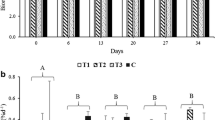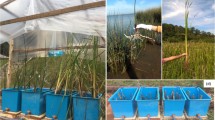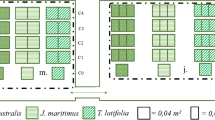Abstract
Seasonal growth characteristics and biomass yield potential of 3 floating aquatic macrophytes cultured in nutrient nonlimiting conditions were evaluated in central Florida’s climatic conditions. Growth cycle (growth curve) of the plants was found to be complete when maximum plant density was reached and no additional increase in growth was recorded. Biomass yield per unit area and time was found to be maximum in the linear phase of the growth curve; plant density in this phase was defined as “operational plant density,” a density range in which a biomass production system is operated to obtain the highest possible yields. Biomass yields were found to be 106, 72, and41 t(drywt)ha-1yr-1, respectively, for water hyacinth (Eichhornia crassipes), water lettuce (Pistia stratiotes), and pennywort (Hydrocotyle umbellata). Operational plant density was found to be in the range of 500–2,000 g dry wt m-2 for water hyacinth, 200–700 g dry wt m-2 for water lettuce, and 250–650 g dry wt m-2 for pennywort. Seasonality was observed in growth rates but not in operational plant density. Specific growth rate (% increase per day) was found to maximum at low plant densities and decreased as the plant density increased. Results show that water hyacinth and water lettuce can be successfully grown for a period of about 10 mo, while pennywort, a cool season plant, can be integrated into water hyacinth/water lettuce biomass production system to obtain high yields in the winter.
Similar content being viewed by others
Literature Cited
A.P.H.A. 1971. Standard methods for the examination of water and wastewater. 13th ed. Amer. Publ. Health Assoc, Washington, DC.
Bagnall, L. O. 1980. Water hyacinth energy aquaculture. Presented at 1980 summer meetings, Amer. Soc. Agric. Engin. p. 20. ASAE Paper No. 80-5042. St. Joseph, MI.
Boyd, C. E. 1969. The nutritive value of three species of water weeds. Econ. Bot. 23: 123–127.
—. 1976. Accumulation of dry matter, nitrogen, and phosphorus by cultivated water hyacinth. Econ. Bot. 30: 51–56.
Center, T. D., and N. R. Spencer. 1981. The phenology and growth of water hyacinth(Eichhornia crassipes [Mart] Solms) in a eutrophic northcentral Florida lake. Aquatic Bot. 10: 1–32.
Cornwell, D. A., J. Zoltek, Jr., C. D. Patrinely, T. des Furman, and J. I. Kim. 1977. Nutrient removal by water hyacinths. J. Water Pollut. Control Fed. 49: 57–65.
DeBusk, T. A., J. H. Ryther, M. D. Hanisak, and L. D. Williams. 1981. Effects of seasonality and plant density on the productivity of some freshwater macrophytes. Aquatic Bot. 10: 133–142.
Hall, D. O. 1980. Biological and agricultural systems: An overview.In Biochemical and Photosynthetic Aspects of Energy Production, ed, A. San Pietro, p. 1–30. Academic Press, New York.
Jackson, G. A. 1980. Marine biomass production through seaweed aquaculture.In Biochemical and Photosynthetic Aspects of Energy Production, ed, A. San Pietro, p. 31–58. Academic Press, New York.
Knipling, E. D., S. H. West, and W. T. Haller. 1970. Growth characteristics, yield potential, and nutritive content of water hyacinth. Proc. Soil & Crop Soc. Florida 30: 51–63.
Reddy, K. R., D. L. Sutton, and G. E. Bowes. 1983. Biomass production of freshwater aquatic plants in Florida. Proc. Soil & Crop Soc. Florida 42: 28–40.
—, P. D. Sacco, D. A. Graetz, K. L. Campbell, and L. R. Sinclair. 1982. Water treatment by an aquatic ecosystem: Nutrient removal by reservoirs and flooded fields. Environ. Mgt. 6: 261–271.
Tucker, S. C, and T. A. DeBusk. 1981. Productivity and nutritive value ofPistia stratiotes andEichhornia crassipes. J. Aquatic PL Mgt. 19: 61–63.
Wolverton, B. C, and R. C. McDonald. 1979. Water hyacinth(Eichhornia crassipes) productivity and harvesting studies. Econ. Bot. 33: 1–10.
Yount, J. L., and R. Crossman. 1970. Eutrophication control by plant harvesting. J. Water Pollut. Control Fed. 42: 173–183.
Author information
Authors and Affiliations
Rights and permissions
About this article
Cite this article
Reddy, K.R., Debusk, W.F. Growth characteristics of aquatic macrophytes cultured in nutrient-enriched water: I. Water hyacinth, water lettuce, and pennywort. Econ Bot 38, 229–239 (1984). https://doi.org/10.1007/BF02858838
Received:
Accepted:
Issue Date:
DOI: https://doi.org/10.1007/BF02858838




